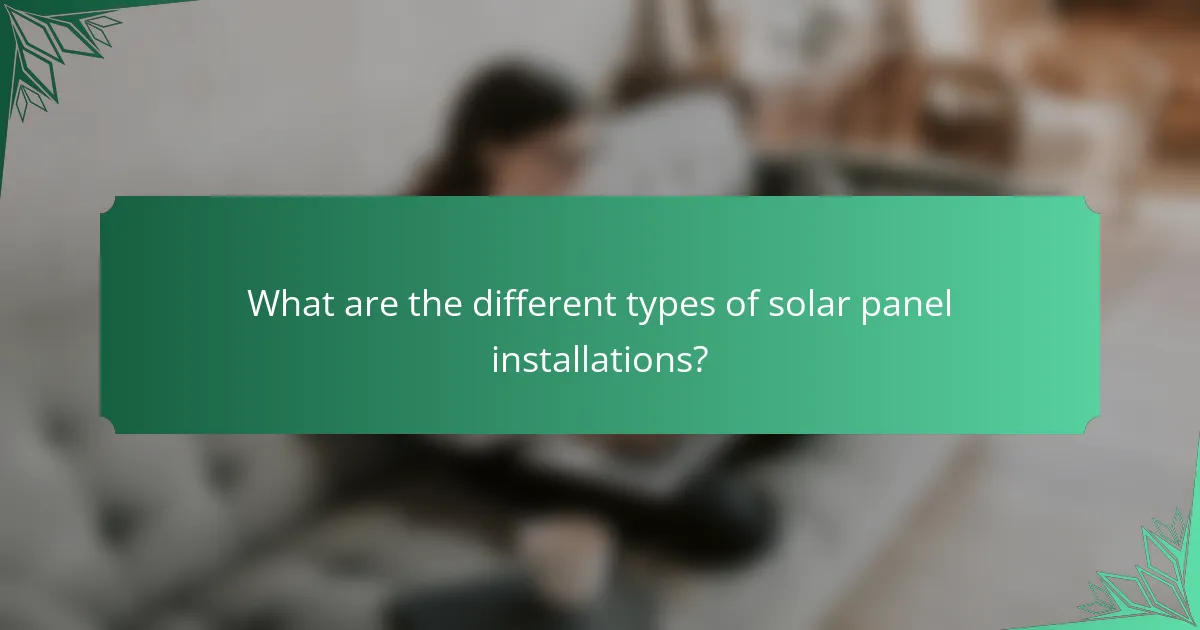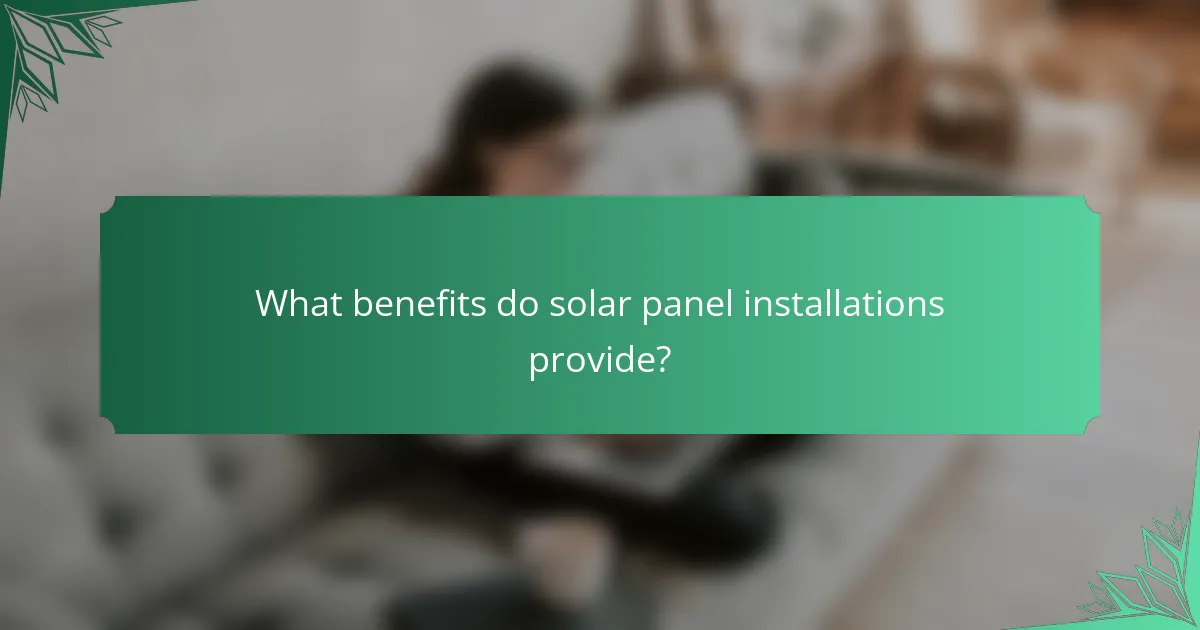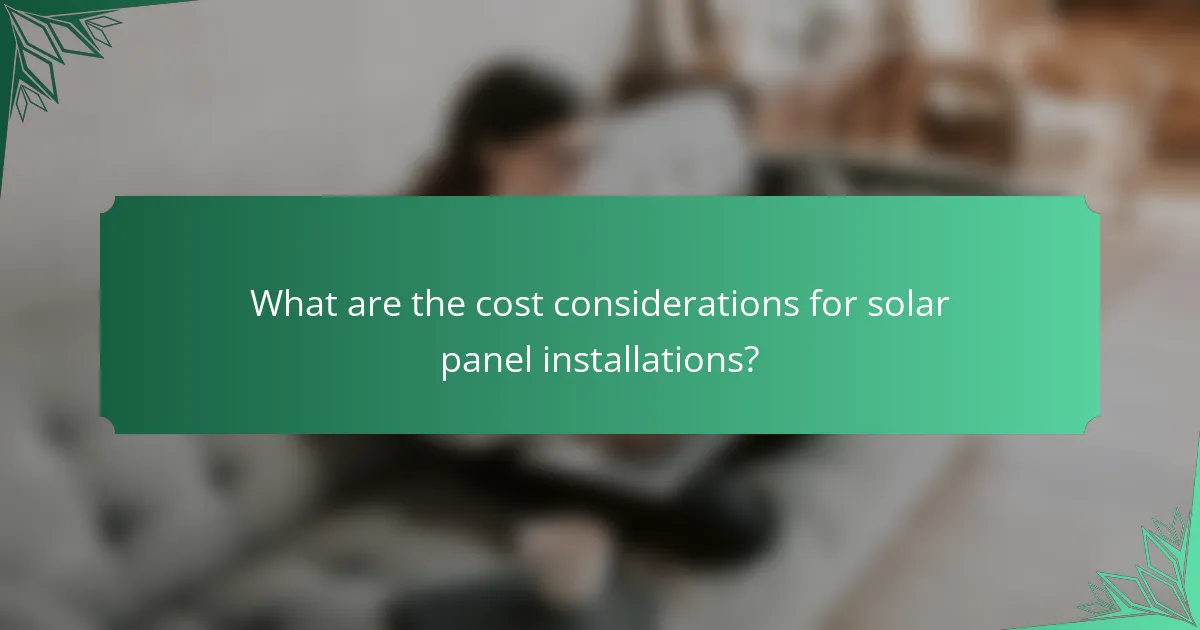
What are the different types of solar panel installations?
There are three main types of solar panel installations: grid-tied, off-grid, and hybrid systems. Grid-tied installations connect directly to the local electricity grid. This type allows homeowners to sell excess power back to the grid. Off-grid installations operate independently from the grid. They rely on battery storage for energy use during non-sunny periods. Hybrid systems combine both grid-tied and off-grid features. They provide flexibility and backup power options. Each type serves different energy needs and preferences.
How do residential solar panel installations differ from commercial ones?
Residential solar panel installations differ from commercial ones primarily in scale and design. Residential systems typically range from 3 kW to 10 kW in size. They are designed to meet the energy needs of individual homes. In contrast, commercial installations can exceed 100 kW and are tailored for larger energy demands of businesses.
Installation complexity varies significantly between the two. Residential installations often feature simpler roof-mounted systems. Commercial systems may involve larger ground-mounted arrays or complex building-integrated designs.
Cost structures also differ. Residential installations generally have lower upfront costs due to smaller system sizes. Commercial installations have higher costs but can benefit from economies of scale.
In terms of financing, residential projects often utilize incentives like tax credits. Commercial installations may access larger financing options and power purchase agreements.
Regulatory requirements can vary as well. Residential projects usually face less stringent regulations than commercial ones. This impacts the permitting process and installation timelines.
Overall, the differences in scale, design, complexity, cost, financing, and regulations distinctly differentiate residential solar panel installations from commercial ones.
What specific features characterize residential solar panel installations?
Residential solar panel installations feature photovoltaic (PV) technology that converts sunlight into electricity. These systems typically include solar panels, an inverter, and a mounting system. Solar panels are often made from silicon and vary in efficiency ratings, usually ranging from 15% to 22%. The inverter converts the direct current (DC) generated by the panels into alternating current (AC) for home use. Mounting systems can be roof-mounted or ground-mounted, depending on property layout and available space. Additionally, residential installations often incorporate battery storage to enhance energy independence. These systems can significantly reduce electricity bills, with homeowners saving an average of 20% to 50% on energy costs. Furthermore, many installations are eligible for tax credits and rebates, making them financially attractive.
What unique attributes define commercial solar panel installations?
Commercial solar panel installations are characterized by their large-scale energy generation capabilities. They typically have higher power output compared to residential systems. These installations often utilize advanced technology such as high-efficiency solar panels. They are designed to meet the energy demands of businesses and industrial facilities. Commercial systems usually have a longer lifespan, often exceeding 25 years. They may also include energy storage solutions to optimize energy use. Additionally, these installations can benefit from government incentives and tax credits. The installation process often involves specialized engineering and site assessments to maximize efficiency.
What are the various types of solar panel systems available?
The various types of solar panel systems available include grid-tied, off-grid, and hybrid systems. Grid-tied systems connect directly to the utility grid. They allow for net metering, where excess energy can be sold back to the grid. Off-grid systems operate independently of the utility grid. They require battery storage to store energy for use when sunlight is not available. Hybrid systems combine both grid-tied and off-grid features. They can switch between using grid power and battery storage as needed. Each type serves different energy needs and installation contexts.
What are the differences between grid-tied and off-grid solar panel systems?
Grid-tied solar panel systems connect to the local electricity grid, while off-grid systems operate independently. Grid-tied systems allow users to sell excess energy back to the grid. Off-grid systems store energy in batteries for use when solar generation is low. Grid-tied systems require no battery storage, reducing initial costs. Off-grid systems typically involve higher upfront costs due to battery and inverter installation. Grid-tied systems provide energy security through grid access. Off-grid systems offer complete energy independence from utility companies.
How do hybrid solar panel systems operate?
Hybrid solar panel systems operate by combining solar energy generation with energy storage and grid connectivity. These systems utilize solar panels to convert sunlight into electricity. The generated electricity can be used immediately or stored in batteries for later use.
When the solar production exceeds the immediate energy demand, excess power is directed to charge the batteries. During periods of low sunlight or high energy demand, the stored electricity can be used to power the home or business.
Additionally, hybrid systems can draw electricity from the grid when needed. This ensures a continuous power supply, regardless of solar generation conditions. According to the U.S. Department of Energy, hybrid systems enhance energy reliability and can lead to cost savings by reducing reliance on grid power.

What benefits do solar panel installations provide?
Solar panel installations provide numerous benefits. They significantly reduce electricity bills by generating renewable energy. Homeowners can save money over time as solar energy often lowers utility costs. Solar panels also increase property value, with studies showing homes equipped with solar systems sell for more. Additionally, solar energy contributes to environmental sustainability by reducing carbon emissions. According to the U.S. Department of Energy, solar energy can decrease greenhouse gas emissions, promoting cleaner air. Furthermore, many governments offer tax incentives and rebates for solar installation, making it financially attractive. This combination of savings, increased value, and environmental benefits makes solar panel installations a compelling choice.
How do solar panel installations contribute to environmental sustainability?
Solar panel installations contribute to environmental sustainability by reducing greenhouse gas emissions. They generate electricity from sunlight, which is a renewable energy source. This process decreases reliance on fossil fuels, which are major contributors to climate change. According to the U.S. Environmental Protection Agency, solar energy can reduce carbon dioxide emissions significantly. For instance, a typical residential solar panel system can offset about 100 tons of carbon dioxide over its lifetime. Additionally, solar panels help conserve water. Traditional energy production often requires large amounts of water for cooling and processing. In contrast, solar energy systems use little to no water. Furthermore, solar installations promote energy independence. They enable households and businesses to generate their own electricity, reducing dependence on external energy sources. Overall, solar panel installations play a crucial role in promoting a sustainable and eco-friendly energy future.
What role do solar panels play in reducing carbon footprints?
Solar panels play a crucial role in reducing carbon footprints by generating clean, renewable energy from sunlight. This process eliminates the need for fossil fuels, which are major contributors to greenhouse gas emissions. According to the U.S. Environmental Protection Agency, solar energy can reduce carbon dioxide emissions by approximately 80% compared to traditional energy sources. Additionally, solar panels can offset the carbon footprint of a household by producing energy that would otherwise come from carbon-intensive sources. In 2020, it was estimated that solar energy helped avoid over 100 million metric tons of CO2 emissions in the United States alone. By adopting solar technology, individuals and businesses can significantly contribute to mitigating climate change and promoting environmental sustainability.
How do solar panel installations impact local ecosystems?
Solar panel installations can significantly impact local ecosystems. They often require land clearing, which can disrupt habitats. This disruption may lead to a loss of biodiversity in the area. Additionally, the installation process can contribute to soil erosion. Solar farms can alter local water drainage patterns, affecting nearby flora and fauna. Research indicates that habitat loss from solar installations can threaten species dependent on those ecosystems. However, properly managed solar projects can mitigate these effects. For example, integrating solar panels with agricultural land can promote coexistence. Overall, the impact varies based on location and installation practices.
What financial advantages do solar panel installations offer to homeowners?
Solar panel installations offer significant financial advantages to homeowners. They reduce electricity bills by generating free energy from sunlight. Homeowners can save an average of $1,500 annually on energy costs. Additionally, solar panels increase property value. Studies show homes with solar systems sell for about 4% more than those without. Many regions offer tax incentives and rebates for solar installation, further lowering upfront costs. Federal tax credits can cover up to 26% of installation expenses. Over time, these savings can lead to a return on investment within 5 to 10 years. Overall, solar panels provide both immediate and long-term financial benefits.
How can solar panel installations reduce energy bills?
Solar panel installations can significantly reduce energy bills by generating electricity from sunlight. This reduces reliance on grid electricity, which is often more expensive. Homeowners can save on their monthly utility costs by using the electricity produced by their solar panels. According to the U.S. Department of Energy, solar energy can lower energy bills by 50% or more. Additionally, excess energy generated can be sold back to the grid, further offsetting costs. Many states offer incentives and tax credits for solar installations, enhancing financial savings. The initial investment in solar panels usually pays off within a few years through these savings.
What incentives and rebates are available for solar panel installations?
Federal tax credits for solar panel installations offer a 30% deduction on the system cost. This incentive is available until 2032. Various states provide additional rebates, which can range from $1,000 to $5,000. Some local utilities also offer cash rebates or performance-based incentives. Net metering policies allow homeowners to receive credits for excess energy produced. Property tax exemptions can prevent increases in property taxes due to solar installations. Additionally, some states have renewable energy certificates (RECs) that can be sold for extra income. These incentives significantly reduce the overall cost of solar panel installations.

What are the cost considerations for solar panel installations?
The cost considerations for solar panel installations include equipment costs, installation expenses, and maintenance fees. Equipment costs typically range from $15,000 to $25,000 for a residential system. Installation expenses can add an additional 10% to 20% to the overall cost. Maintenance fees are generally low, averaging around $300 to $500 annually. Additionally, local incentives and tax credits can significantly reduce upfront costs. The federal solar tax credit allows homeowners to deduct 26% of installation costs from their federal taxes. Overall, the total cost can vary based on system size, location, and available incentives.
How do installation costs vary by type of solar panel system?
Installation costs vary significantly by type of solar panel system. Traditional monocrystalline panels typically have higher installation costs due to their efficiency and advanced technology. These costs can range from $2.50 to $3.50 per watt. Polycrystalline panels, while slightly less efficient, usually have lower installation costs, averaging between $2.00 to $3.00 per watt. Thin-film solar panels often have the lowest installation costs, ranging from $1.50 to $2.50 per watt. The differences in costs arise from factors such as the materials used, installation complexity, and system efficiency. Higher efficiency systems may require more specialized installation techniques, thus increasing labor costs. Conversely, simpler systems can be installed more quickly and with less expertise, reducing overall installation expenses.
What factors influence the total cost of residential solar panel installations?
The total cost of residential solar panel installations is influenced by several key factors. These factors include the type of solar panels chosen, which can vary in price and efficiency. The size of the installation, measured in kilowatts, directly affects the overall cost. Labor costs vary by region and can significantly impact the final price. Furthermore, local incentives and rebates can reduce the net cost for homeowners. The complexity of the installation site, such as roof angle and accessibility, also plays a role in determining installation costs. Additionally, the choice of inverter technology can influence expenses. Lastly, equipment warranties and financing options can further affect the total investment in solar energy systems.
How do commercial solar panel installation costs compare?
Commercial solar panel installation costs vary based on several factors. On average, these costs range from $2.50 to $3.50 per watt. This translates to a total installation cost of approximately $50,000 to $100,000 for a typical 20 kW system. Factors influencing these costs include system size, type of panels used, and local labor rates. Additionally, incentives such as tax credits can significantly reduce overall expenses. According to the Solar Energy Industries Association, prices have dropped by over 70% in the last decade, making solar more accessible for businesses.
What are the long-term financial implications of investing in solar panels?
Investing in solar panels typically results in significant long-term financial savings. Homeowners can save between $10,000 to $30,000 over 20 years on energy bills. Additionally, solar panels can increase property value by an average of 4.1%, according to a study by the National Renewable Energy Laboratory. Tax incentives, such as the federal solar tax credit, can further enhance savings by covering a portion of installation costs. The initial investment often pays off within 5 to 10 years, depending on local energy prices and installation costs. Ongoing maintenance costs are relatively low, averaging around $300 per year. Overall, solar panels provide a stable hedge against rising energy costs over time.
How does the payback period for solar panel installations work?
The payback period for solar panel installations is the time it takes for the energy savings to equal the initial investment cost. This period is calculated by dividing the total installation cost by the annual savings on electricity bills. For instance, if a solar panel system costs $20,000 and saves $4,000 per year, the payback period is 5 years. Factors affecting the payback period include local electricity rates, available incentives, and system efficiency. According to the National Renewable Energy Laboratory, the average payback period for residential solar systems ranges from 5 to 15 years. This variability depends on geographic location and specific energy needs.
What financing options are available for solar panel installations?
Solar panel installations can be financed through various options. Common financing options include cash purchases, solar loans, leases, and power purchase agreements (PPAs). Cash purchases provide full ownership and immediate savings. Solar loans allow homeowners to pay over time while still benefiting from tax credits. Leases require little to no upfront cost but do not provide ownership. PPAs involve paying for the power generated at a fixed rate, often lower than utility rates. According to the Solar Energy Industries Association, these options make solar energy accessible to a wider range of consumers.
What practical tips should be considered before installing solar panels?
Consider the orientation and angle of your roof before installing solar panels. South-facing roofs typically receive the most sunlight. Assess the shading from trees or buildings that could impact efficiency. Evaluate the structural integrity of your roof to ensure it can support the panels. Research local zoning laws and building codes that may affect installation. Obtain multiple quotes from reputable solar installers to compare pricing and services. Check for available incentives or rebates that can reduce installation costs. Review the warranty options for both the panels and the installation work. Finally, think about your long-term energy needs to determine the appropriate system size.
The main entity of the article is solar panel installations, which are categorized into three types: grid-tied, off-grid, and hybrid systems. The article provides a comprehensive overview of the distinct characteristics and benefits of residential versus commercial solar panel installations, including their scale, design, cost structures, and financing options. It also discusses the environmental sustainability of solar energy, detailing how installations reduce carbon footprints and contribute to cleaner air. Additionally, the article examines financial advantages, cost considerations, and practical tips for homeowners considering solar panel systems.